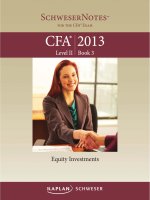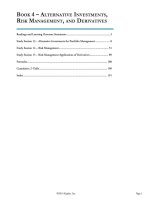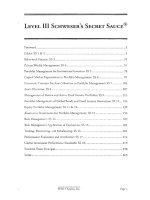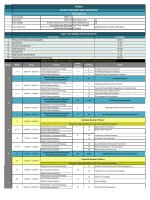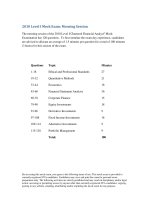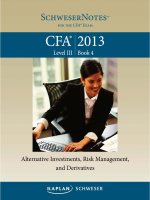CFA level 3 mock exam 4 level 3 mock 2017
Bạn đang xem bản rút gọn của tài liệu. Xem và tải ngay bản đầy đủ của tài liệu tại đây (541.08 KB, 163 trang )
FinQuiz.com
CFA Level III Mock Exam 4
June, 2017
Revision 1
Copyright © 2010-2017. FinQuiz.com. All rights reserved. Copying, reproduction
or redistribution of this material is strictly prohibited.
CFA Level III Mock Exam 4 – Questions (AM)
FinQuiz.com – 4th Mock Exam 2017 (AM Session)
The morning session of the 2017 Level III CFA Examination has 8 questions. For
grading purposes, the maximum point value for each question is equal to the number of
minutes allocated to that question.
Questions Topic
Minutes
1
Portfolio Management – Behavioral Finance
20
2
Portfolio Management – Institutional Investors
20
3
Portfolio Management – Fixed Income Investments
19
4
Portfolio Management – Individual-Asset Allocation
39
5
Portfolio Management – Asset Allocation
22
6
Portfolio Management – GIPS
20
7
Portfolio Management – Trading and Rebalancing
Portfolio Management – Risk Management & Performance
Evaluation
20
8
Total:
FinQuiz.com © 2017 - All rights reserved.
20
180
2
CFA Level III Mock Exam 4 – Questions (AM)
QUESTION 1 HAS FOUR PARTS (A, B, C, AND D) FOR A TOTAL OF 20
MINUTES
Dano Parker works as a portfolio manager at Picasso Investments (PICIN), a large and
reputable financial advisory firm offering a range of capital management services and
investment products to individual and institutional investors. Parker has been with the
firm for over five years now, and has managed more than fifteen client portfolios. As
such, PICIN has appointed Parker to appraise the performance of private wealth
portfolios at regular intervals. During his appraisals, and also as part of experience,
Parker notices that, in many instances, the assumptions of traditional finance with respect
to the behaviors of individuals do not hold true. Parker was not sure what effects this
might have on optimal portfolio construction by financial market participants. To discuss
this further, Parker invited David Hulsey, a behavioral financial analyst, to talk about
investor behavior in detail. During their conversation, Hulsey made the following
comment:
“I believe that investors behave rationally when making investment decisions and try to
maximize the expected utility, given their budget constraint. When faced with new
information, market participants revise expectations consistent with Bayes’ formula.
Also, investors are risk-averse, demanding more return for each unit of risk.”
Parker disagreed with Hulsey on the basis of the ‘Prospect Theory’, but was not sure how
this theory provided an alternative explanation to investor behavior. He was, however,
convinced that the theory explained apparent deviations in decision making from those
explained under the utility theory.
A. Justify how the prospect theory supports Parker’s notion of an apparent departure
of investor behavior from the behavior of the rational economic man. Give three
ways the prospect theory differs from the utility theory.
(6 minutes)
FinQuiz.com © 2017 - All rights reserved.
3
CFA Level III Mock Exam 4 – Questions (AM)
After his meeting with Hulsey, Parker proceeded with developing an earnings forecast for
Sparkle Fixtures Incorporated (SFI), a US firm famous for its lighting fixtures and
decorative lamps. The lighting industry has seen tremendous growth over the past decade
due to a rising trend of professional interior designing of homes and offices. Historical
data of the past 15 years shows earnings growth for SFI at 1.0-1.5% above the GDP
growth rate. Just recently, however, the firm reported a drop of 5.0% in earnings growth
due to a number concerns regarding the supply of raw materials. In addition, a few other
firms also reported losses for the recent quarter. In developing his forecasts, Parker
decided to revise his earnings estimate downward for the stock in order to avoid any
losses and keep his estimate conservative.
B. Determine the bias that Parker is most likely subject to while developing earnings
estimate for SFI. Give one example where such a bias may result in excessive
trading by financial market participants.
(4 minutes)
While reviewing the asset allocation decisions of his clients, and their stated preferences
during regular meetings for updating their IPSs, Parker noticed that many portfolios
lacked the appropriate amount of diversification, as would be present if investors behaved
rationally and took a holistic view of their portfolios. Parker was assured that this was
due to the presence of behavioral biases.
C. Give three behavioral explanations for inadequately diversified portfolios. State
the bias inherent in each explanation.
(6 marks)
Before ending his day, Parker shortlisted five potential stock investments for his portfolio
that met his risk and return constraints and had approximately similar risk-return profiles.
Given his budget constraint, Parker decided to invest in two of the most well-known and
established firms amongst those he had shortlisted.
D. Determine, using behavioral finance, the behavior that guided Parker to select
stocks for his portfolio. State the bias leading to such a behavior. Justify your
response.
(4 marks)
FinQuiz.com © 2017 - All rights reserved.
4
CFA Level III Mock Exam 4 – Questions (AM)
QUESTION 2 HAS FOUR PARTS (A, B, C, D) FOR A TOTAL OF 20 MARKS
Renee Russo works as a portfolio manager at Panther Investment Management Firm
(PIMF), a financial advisory firm offering portfolio management services to institutional
investors, including pension plans, endowments and foundations. Pension funds make up
the largest portfolio of PIMF’s client base. Russo has recently been appointed as the
Chief Portfolio Manager (CPM) for the pension fund of Revolutionary Technologies
Limited (RTEL), a large, US based firm operating in the electronics and technology
industry. The firm has been quite profitable over the past five years, as has been the
general industry trend. Working in association with Dennie Thorpe, the Chief Financial
Officer (CFO) of RTEL, Russo compiles the data provided in Exhibit 1.
Exhibit 1:
Financial Information of RTEL (Average of the past five years)
RTEL
Industry Average
Debt/Total Assets
35%
55%
Net Income/Sales
22%
19%
Expected Gross Profit
Margin
45%
47%
Russo’s team at PIMF presents her with the data in Exhibit 2.
Exhibit 2:
Economic Data
Duration
25 year, US Treasury bonds 16 years
35 year, US Treasury bonds 22 years
Interest Rate
7.5%
8.5%
Inflation rate:
5.0%
FinQuiz.com © 2017 - All rights reserved.
5
CFA Level III Mock Exam 4 – Questions (AM)
Utilizing the opportunity to work with the CFO of the firm, Russo also accumulates the
following facts:
•
•
•
•
•
The projected benefit obligation (PBO) as reported on the current balance sheet,
dated 31 December 2013, equals $10 billion.
The duration of the liabilities equals 22 years.
The total value of the firm’s pension assets as of 31 December 2013 equal $13
billion.
The ratio of the retired lives to active lives for the firm equals 0.33.
The correlation between pension plan assets and plan liabilities is close to 0.33,
with pension assets invested mostly in growth oriented investments.
While talking to Russo about the pension plan’s objectives, Thorpe also states the
following:
“RTEL primary focus is to maintain the funded status of the plan at a level of at least
100% with respect to the PBO. The board has decided that a probability of 10% of falling
short of meeting this objective is reasonable. In addition, the plan’s objectives need to be
set so as to minimize the probability of making future contributions to the plan. Also,
since proficient human resource is a key element of success in this industry, to retain our
employees, we keep modifying our plan provisions according to changes in the industry.
This helps ensure retention of the best possible human resource in the face of
competition.”
Thorpe continues with the following comment:
“To meet our long-term objectives of minimizing contributions, the board has estimated
that a return of 2.5% over and above the minimum required return would be appropriate
for the fund.”
A. Formulate an appropriate risk objective for Revolutionary Technologies
Limited’s (RTEL) pension fund. Determine whether RTEL’s ability to take risk
is above-average, average, or below average. Give three reasons why the ability
may be high, and three reasons why it might be low. Use the template on page 8
to answer the question.
(8 marks)
FinQuiz.com © 2017 - All rights reserved.
6
CFA Level III Mock Exam 4 – Questions (AM)
B. Determine the minimum return requirement for RTEL’s pension fund.
Formulate an appropriate return objective for the RTEL pension fund.
(4 marks)
Ten years have passed, and Russo is still the manager of the RTEL pension fund. The
following changes have occurred during this time period:
•
•
•
•
The ratio of the retired lives to average lives is 0.66.
The industry has seen a large number of new entrants, which has squeezed profit
margins for existing firms. The overall growth rate of the industry is now
approximately in line with the rate of growth of the general economy.
The firm introduced a provision for early retirement two years ago. 10% of
employees have opted for this option.
The asset base is now $9 billion with plan liabilities unchanged.
For the current month, RTEL made a contribution to the pension plan of $10 million.
Given the number of retired employees, Russo estimates a cash disbursement of $60
million per month to satisfy obligations.
C. Determine the current liquidity requirement of the RTEL pension fund. Explain
whether the liquidity constraint for the fund has improved, remained stable, or
deteriorated. Justify your response with three reasons.
(5 marks)
D. Formulate the time horizon portion of the IPS of the RTEL pension fund as of
today and ten years ago.
(3 marks)
FinQuiz.com © 2017 - All rights reserved.
7
CFA Level III Mock Exam 4 – Questions (AM)
Template for Question 2-D
Reasons (High)
Ability
to
take
risk
Reasons (Low)
1.
1.
2.
2.
3.
3.
FinQuiz.com © 2017 - All rights reserved.
8
CFA Level III Mock Exam 4 – Questions (AM)
QUESTION 3 HAS FIVE PARTS (A, B , C , D, E) FOR A TOTAL OF 19 MARKS
Target Lock Investment Firm (TLIF) operates in the financial services industry of USA.
TLIF is known for its expertise in managing equity portfolios and growth-oriented stock
investments. Given the immense success in this area, TLIF’s CEO, Michael Dobson,
believes it strategically wise to include the fixed-income asset class to their investment
universe. Accordingly, he hires Natalie Acosta, a fixed-income analyst and portfolio
manager, to introduce the TLIF Debt Fund, a new product, to TLIF’s clients and
prospects. To determine which issues to include in the fund, Acosta works with the
research department to collect the data presented in Exhibit 1.
Exhibit 1:
Spread Data for Three Bond Issues
Issue
Current Spread
Standard Deviation of
Spread
Mean Spread over
the past year
TYS Co.
220 bps
57 bps
165 bps
RLO Firm
260 bps
45 bps
215 bps
Ace Inc.
200 bps
30 bps
165 bps
A. Determine the issue that should most likely be purchased given the above
information. Give two limitations of the bond selection approach used.
(4 marks)
Acosta has considerable experience in constructing trading strategies in the fixed-income
market. For the current economic state, Dobson predicts the following:
Prediction 1: “The economy appears to be at a business cycle trough given low consumer
demand and low interest rates. In the coming six months, the economy will
start picking up as demand rises.”
Prediction 2: “The US Treasury bonds term structure is expected to flatten in the near
future. In a year or so, economic conditions may lead to an inversion of the
term structure for government bonds.”
FinQuiz.com © 2017 - All rights reserved.
9
CFA Level III Mock Exam 4 – Questions (AM)
B. Construct two trading strategies that would be profitable given that Acosta’s
predictions are accurate. Justify your response for each.
(4 marks)
A year after the launch of the TLIF Debt Fund, Acosta reviews the performance of the
fund to determine any portfolio rebalancing that might be needed. The fund had invested
in 10,000 bonds of RLO Firm, each with a par value of $1,000. Acosta is concerned with
the possibility of a rating downgrade that could seriously affect the fund’s return. Given
her strong opinion about the possibility of an adverse event, Acosta decides to liquidate
the holdings in RLO Firm’s bond issues.
C. Determine two ways in which Acosta can hedge the risk of RLO’s bond holdings
without having to liquidate the position. Explain how they could offer protection
from the expected risk factor.
(4 marks)
Five years later, the TLIF Debt Fund has managed to establish a place amongst the
highest rated fixed-income funds in the area. Last year, Acosta decided to include
international bonds in the asset-mix and consequently, had hired a team of portfolio
managers for the management of international bond investments. As such, the fund has
considerable holdings in French bonds, UK bonds and Japanese bonds. In a recent
meeting with the fixed-income analysts, Acosta was presented the following data:
Exhibit 2:
Annual Interest Rate Data
Japan
Germany
UK
Short-term interest rates
2.0%
4.5%
6.5%
Currency appreciation
relative to the dollar
3.5%
0.35%
-0.40%
*The U.S. risk free rate is 5.0%
D. Assuming that the IRP holds, determine whether the investments in the foreign
bonds should be hedged or not. Justify your response.
(4 marks)
FinQuiz.com © 2017 - All rights reserved.
10
CFA Level III Mock Exam 4 – Questions (AM)
On further analysis of the data provided to her, Acosta determined that French bonds
provided attractive returns to foreign investors. Acosta particularly short listed a French
bond that had a duration of 8 and provided an annual return of 5.5%. A similar bond in
Japan offered a return of 2.0% and had a duration of 9.
E. Determine the spread widening that would cause the additional yield advantage
to a Japanese investor investing in French bonds to be wiped out. Show your
calculations.
(3 marks)
FinQuiz.com © 2017 - All rights reserved.
11
CFA Level III Mock Exam 4 – Questions (AM)
QUESTION 4 HAS FIVE PARTS (A, B, C, D, E) FOR A TOTAL OF 39 MARKS
John Devlin is a portfolio manager at All-Mark Associates (AMA), a financial advisory
firm that manages portfolios for high net worth individual clients. AMA has gained
significant acclaim in the financial community, and the core reason for its success is its
strategy of appointing a dedicated portfolio manager for each of its clients. As such,
Devlin has been assigned the task of managing the portfolio of Sean Hart, a private
wealth investor that just joined AMA as a client.
Hart is a renowned physician and works at a state-owned hospital in Massachusetts,
USA. His superior technical expertise, professionalism and interpersonal skills, have
contributed to his success in the medical community. Consequently, after ten years of
working as a physician, Hart was offered a distinguished administrative position in his
hospital around five years ago. Hart is 45 years old and has decided to stay single. He is,
however, very close to his mother, who lives alone and left her job ten years ago. Hart
pays her $50,000/year to support her living expenses; he would continue to do so for the
coming five years, after which, his mother’s pension disbursements will support her. Hart
goes to the gym regularly, and has managed to keep himself physically fit and healthy.
During the course of several meetings with Hart, Devlin accumulated the following facts:
•
•
•
•
•
•
•
•
Hart earns a salary of $200,000/year as a physician, and an additional $50,000 for
the administrative duties.
Hart is planning to renovate his home and needs $40,000 in the coming three
months for this purpose.
Hart wishes to donate $20,000 next month to a charity that funds the education
expenses of orphans.
Hart’s living expenses average $300,000/ year.
Before he passed away, Hart’s father put some money in a trust fund that pays
Hart $15,000/year.
The income tax applicable to Hart equals 25% and the gift fund is subject to a
15% tax rate.
Hart’s expenses and salary are expected to increase with inflation.
The risk-free rate is 5% and the inflation rate is 3.0%.
FinQuiz.com © 2017 - All rights reserved.
12
CFA Level III Mock Exam 4 – Questions (AM)
With his hard work at the hospital, Hart has managed to accumulate a significant amount
of assets. Exhibit 1 displays details about them.
Exhibit 1:
Investable Assets
Investable Assets
Amount
Stock holdings
$50,000
Bond holdings
$2,000,000
Co. Stock
$500,000
Cash
$40,000
Home
$1,200,000
Gold
$200,000
*Stock holdings represent investments in stable, value stocks
Ten years after he stops making payments to his mom, Hart wants at least $3,000,000 in
investable assets. Even though his employer’s stock forms a considerable portion of his
investable assets, Hart wants Devlin to carefully analyze the profitability and
appropriateness of the investment. He is prepared to liquidate the holding if
circumstances suggested.
A. Formulate the return objective portion of Hart’s IPS. Show your calculations.
(10 marks)
B. Determine whether Hart’s ability and willingness to take risk are above-average,
average, or below-average. Justify your response with three reasons each. Use the
template on page 15 to answer this question.
(8 marks)
C. Formulate the liquidity constraint portion of Hart’s IPS.
(5 marks)
D. Determine the personality type that Hart would fall into. Justify your response
with three reasons.
(5 marks)
FinQuiz.com © 2017 - All rights reserved.
13
CFA Level III Mock Exam 4 – Questions (AM)
After his analysis, Devlin considers the asset allocations given in Exhibit 2 for Hart.
Exhibit 2:
Proposed Asset Allocation Alternatives
Asset Class
Allocation A
Allocation B
Allocation C
Allocation D
Cash
10%
5%
0%
5%
Corporate bonds
0%
20%
10%
15%
Government bonds
Large-cap US
stocks
Small-cap US
stocks
International
stocks
Real estate
40%
15%
5%
10%
20%
20%
25%
20%
20%
20%
20%
30%
-
10%
20%
10%
10%
10%
15%
5%
Venture Capital
-
0%
5%
0%
He also gathered the information given in Exhibit 3.
Allocation
Exhibit 3:
Data on the Asset Allocations
After-tax, Nominal
Standard Deviation
Expected Return
A
16.66%
22.0%
B
12.99%
14.50%
C
21.00%
29.90%
D
12.50%
18.40%
The risk-free rate is 3.0%.
E. Determine the asset allocation that is most appropriate for Hart. Justify your
response with four reasons. For each of the allocations not selected, give one
reason each why they were not appropriate. Use the template provided on page 16
to answer the question
(11 marks)
FinQuiz.com © 2017 - All rights reserved.
14
CFA Level III Mock Exam 4 – Questions (AM)
Template for Question 4-B
Risk
tolerance
Circle one
Reasons
1.
Ability to
take risk
Aboveaverage
2.
Below
Average
3.
1.
Willingness
to take risk
Above
average
2.
Below
average
3.
FinQuiz.com © 2017 - All rights reserved.
15
CFA Level III Mock Exam 4 – Questions (AM)
Template for Question 4-E
Recommended
asset allocation
(circle one)
Allocation
Four Reasons to support decision
For each of the allocations
not selected, give one reason
each why they were not
appropriate.
1
i.
2
ii.
A
B
3
C
iii.
D
4
FinQuiz.com © 2017 - All rights reserved.
16
CFA Level III Mock Exam 4 – Questions (AM)
QUESTION 5 HAS THREE PARTS (A , B , C) FOR A TOTAL OF 22 MARKS
Parallel Investments (PARIN) is a capital management firm that offers its advisory
services to large, institutional funds like pensions, endowments and foundations. The
Gems Foundation (TGM) is one of the largest clients of PARIN. TGM core objective is
to fund educational institutes that provide free of cost educational services to underprivileged children between 5-15 years of age.
The foundation has accumulated a portfolio worth $50 million. TGM’s investment policy
statement dictates the following:
•
•
•
•
•
•
•
•
TGM has an annual spending requirement of $2,375,000.
TGM’s expenses are expected to rise with the expected rate of inflation of 3.0%.
PARIN estimates that the cost of earning investment returns equals 50bps.
TGM wants the appropriate asset allocation to minimize the probability of the
annual portfolio return falling below TGM’s spending rate.
TGM has decided to donate $2,500,000 to a charitable organization in the coming
three months. This cash outflow is to be excluded from TGM’s investable asset
base.
TGM’s board has decided that a worst-case return of -13.5% is acceptable during
any 12-month period. However, the probability of failing to meet this return level
should be minimized to 5.0%.
T-bills offer a rate of 2.5%.
The maximum acceptable standard deviation to TGM’s board is 17.0%.
Using the information in TGM’s IPS, Ben Spencer, a portfolio manager at PARIN, shortlisted the following asset classes:
1.
2.
3.
4.
5.
U.S. Equities.
International equities.
Corporate bonds.
Government bonds.
Real Estate.
Using these asset classes, Spencer determined five possible asset allocations given his
capital market expectations. These are displayed in Exhibits 1 and 2.
FinQuiz.com © 2017 - All rights reserved.
17
CFA Level III Mock Exam 4 – Questions (AM)
Exhibit 1:
Corner Portfolios given PARIN’s Capital Market Expectations
Corner Portfolio
Expected Return
Standard Deviation
Sharpe Ratio
A
9.90%
16.66%
0.517
B
8.71%
13.20%
0.650
C
7.50%
13.00%
0.635
D
6.24%
7.8%
0.612
E
5.50%
6.5%
0.600
Exhibit 2:
Asset Allocations
Corner
Portfolio
Asset Class 1
Asset Class 2
Asset Class 3
Asset Class 4
Asset Class
5
A
50%
30%
10%
0%
10%
B
30%
20%
15%
25%
10%
C
40%
20%
10%
25%
5%
D
20%
50%
10%
10%
10%
E
35%
25%
30%
0%
10%
A. Determine the asset allocation that would be most appropriate for The Gems
Foundation. Justify your selection with three reasons. Show your calculations.
Find the weights for each asset class in the optimal asset allocation.
(12 marks)
Spencer has managed TGM’s portfolio for a number of years now. The foundation’s
portfolio is invested in an asset allocation that has a Sharpe ratio of 0.52. Spencer is
considering adding international bonds to the asset mix to improve the risk profile of the
portfolio. However, he is not sure whether adding another asset class would prove
fruitful. International bonds have a predicted Sharpe ratio of 0.45 and a predicted
correlation with TGM’s portfolio of 0.60.
FinQuiz.com © 2017 - All rights reserved.
18
CFA Level III Mock Exam 4 – Questions (AM)
B. Determine whether TGM should add international bonds to its existing portfolio.
Justify your response.
(4 marks)
Spencer was not sure about the addition of international bonds. However, he is convinced
that adding emerging market equities to TFM’s portfolio would not only increase the
portfolio’s returns but would also decrease the overall risk. When Spencer talked about
this with Andrew Selle, his colleague, Sell made the following comment:
“You might be right, but I am concerned with the risks associated with investment in
such markets.”
To this, Selle replied with the following comment:
“Emerging market equities can serve as a valuable addition to the existing portfolio by
improving its risk/return profile. Markets are becoming increasingly integrated now,
which has served to mitigate some of the concerns of investing in emerging economies.”
C. Determine the effect of market integration on the following:
•
•
•
Equity prices.
Expected return.
Return volatility.
Justify your response for each of the above.
(6 marks)
FinQuiz.com © 2017 - All rights reserved.
19
CFA Level III Mock Exam 4 – Questions (AM)
QUESTION 6 HAS FOUR PARTS (A, B, C, D) FOR A TOTAL OF 2O MINUTES
Capital Enhancement Investment Group (CEIG) is a capital management firm in the US
that holds a prestigious position amongst similar firms in its industry. CEIG has
introduced a number of revolutionary products in the financial industry that combine
traditional assets with simultaneous derivative positions to cash on profitable
opportunities. To remain competitive in this growing industry, CEIG appointed James
Hull, a compliance officer, to implement the Global Investment Performance Standards
(GIPS) within the firm. Hull has worked with CEIG for over three years now and deems
himself fruitful in the proper implementation of the Standards. CEIG considers itself
amongst the list of GIPS complaint firms, and, in doing so, believes it has gained the trust
of many prospective clients. Just recently, the CEO of CEIG hired Darin Hollings, a
performance evaluation and presentation expert, to review the firm’s procedures for GIPS
compliance. During his review, as of January 2011, Hollings noted the following:
•
•
•
•
•
CEIG used trade date accounting to report transactions. Assets and liabilities were
recognized within a week of entering into a transaction.
When reporting fixed-income securities, interest income earned but not yet
received was also included in their total value. For dividend paying equities,
dividends not yet paid were not accrued due to their uncertainty.
CEIG has a fiscal year that corresponds to the calendar year. Consequently, every
portfolio within its composites was valued at the last business day of each year.
When reviewing the frequency of portfolio valuations, Hollings discovered that
CEIG valued all portfolios at least monthly.
When presenting net-of-fees returns, CEIG did not accrue investment
management fees, especially performance-based fees.
After the review, Hollings met with the CEO and posed the following question:
“In reporting portfolio values, which definition of value do you use?”
The CEO responded with the following comment:
“Last year, we measured and reported all portfolio values at market value. However,
recently, we have started to use the ‘fair value’ of portfolios for reporting purposes. If fair
values are not easily obtainable, a best estimate of market value is used.”
FinQuiz.com © 2017 - All rights reserved.
20
CFA Level III Mock Exam 4 – Questions (AM)
A. List three ways in which CEIG’s procedures violate the GIPS requirements with
regards to input data. Support your answer with proper justifications for each
reason.
(6 marks)
After his review, Hollings proceeded with evaluating the performance of the portfolios
managed by CEIG’s portfolio managers. While doing so, Hollings met with Ricardo
Nadu, a portfolio manager who managed a few of the firm’s private wealth accounts.
Nadu told Hollings that all portfolio managers were required to measure the timeweighted rates of return that adjusted for external cash flows. In addition, returns for
longer measurement periods were computed by geometrically linking the monthly
returns. Upon further questioning by Hollings, Nadu stated the following:
•
•
•
•
•
•
Cash and cash equivalents were included in the total return calculations.
However, if the cash was not actually invested by the same group of portfolio
managers that managed the portfolio, it was excluded from the return calculations.
In addition, returns were always calculated after the deduction of trading
expenses. To be conservative and ensure compliance with GIPS, if actual values
for such expenses were unavailable, estimated values were used based on
historical averages.
Custody fees were not considered direct trading expenses. However, if they were
charged on a per-transaction basis, they were included in trading expenses.
When trading expenses could not be broken out of bundled fees, gross-of-fee
returns were reduced by the entire amount of the bundled fee to estimate returns
gross of investment management fees.
Withholding taxes were not considered when estimating net of fee returns.
CEIG’s definition of what constituted ‘a large cash flow’ varied with each
composite depending on the nature of the investment strategy.
B. For each of the facts stated by Nadu, state whether they are in compliance with
the GIPS. For each of the procedures not in compliance, determine the changes
necessary to make them GIPS compliant. Use the template on the following page
to answer the question.
Answer Question 6-B in the Template provided on page 23.
(6 marks)
FinQuiz.com © 2017 - All rights reserved.
21
CFA Level III Mock Exam 4 – Questions (AM)
Hollings knew that his analysis of CEIG would not be complete without assessing the
appropriateness of the construction of composites within CEIG. Specifically, Hollings
analyzed the following actual, fee-paying client portfolios:
Portfolio A
The client specifically instructed not to invest more than 10% of the portfolio
value or 115% of the benchmark weight, whichever is greater, in any given
economic sector.
Portfolio B
The client is the CEO of his firm and has holdings in his company’s stock.
He has instructed his portfolio manager not to sell any part of this holding,
even if capital market conditions stated otherwise.”
Portfolio C
More than 60% of the client’s portfolio constitutes holdings in his
grandfather’s firm that has been managed by family over the course of many
years. Since the holding has a very low cost basis, the client has directed his
portfolio manager that it should not be sold.”
C. Select the portfolio that is likely to be not included in a composite under the
Global Investment Performance Standards. For the portfolio selected, list three
ways in which it can be handled with regards to GIPS compliant composite
construction.
(4 marks)
Hollings was particularly interested in the firm’s traditional asset class composites,
mainly:
1. Balanced Fund Composite (50% equities, 50% fixed income).
2. Growth Fund Composite (70% equities, 30% fixed income).
3. Income Fund Composite (30% fixed income, 70% equities).
The equity portions of the three funds were managed by a group of equity managers at
CEIG, whereas the fixed-income portions, along with cash and cash equivalents, were
managed by the fixed-income managers. Just recently, CEIG created a new composite by
the name of “Standard Equity Account Composite” that included only the equity
segments of the above-mentioned composites. This was created to ensure proper
performance evaluation of the equity managers of CEIG.
D. Determine whether the construction of the new composite is in compliance with
the GIPS. Support your answer with two reasons.
(4 marks)
FinQuiz.com © 2017 - All rights reserved.
22
CFA Level III Mock Exam 4 – Questions (AM)
Template for Question 6-B
Procedures
Compliance Changes (if necessary)
with GIPS
to be in compliance
Cash and cash equivalents were included
in the total return calculations. However,
if the cash was not actually invested by
the same group of portfolio managers
that managed the portfolio, it was
excluded from the return calculations.
Custody fees were not considered direct
trading expenses. However, if they were
charged on a per-transaction basis, they
were included in trading expenses.
When trading expenses could not be
broken out of bundled fees, gross-of-fee
returns were reduced by the entire
amount of the bundled fee to estimate
returns gross of investment management
fees.
In addition, returns were always
calculated after the deduction of trading
expenses. To be conservative and ensure
compliance with GIPS, if actual values
for such expenses were unavailable,
estimated values were used based on
historical averages.
Withholding taxes were not considered
when estimating net of fee returns.
CEIG’s definition of what constituted ‘a
large cash flow’ varied with each
composite depending on the nature of
the investment strategy.
FinQuiz.com © 2017 - All rights reserved.
23
CFA Level III Mock Exam 4 – Questions (AM)
QUESTION 7 HAS THREE PARTS (A, B, C) FOR A TOTAL OF 20 MARKS
Jocelyn Mathews works as a portfolio manager at Victor Investment and Capital
Management (VICM). Mathews manages a number of VICM’s private wealth accounts
invested in asset classes ranging from equities and fixed-income to alternative
investments. Mathews believes strongly in not only the value of research and analysis in
proper security selection, but also in the significance of trading and implementation in
managing costs. Accordingly, he is analyzing the trading costs of his most recent
purchase: 1,000 shares of the stock of Stripes Incorporated. He accumulates the following
facts for his evaluation:
•
•
•
•
The benchmark price was $60.00/share.
The order was placed on last Tuesday, when the shares of Stripes closed at
$59.90/share. 500 shares were purchased at a price of $61.05 per share.
Commissions and fees were $50.
On Wednesday, 200 more shares were purchased at $62.05 per share.
Commissions and fees were $20. Shares of Stripes closed at $61.03 during the
same day.
On Thursday, no more shares were purchased and the order was canceled. The
market closed at $62.00 per share.
Mathews meant to use this data to calculate the implementation shortfall of his trade.
A. Calculate the total implementation shortfall for the trade in the stock of Stripes
Incorporated. Determine the contribution of the various cost components to the
total implementation shortfall. Show your calculations.
(6 marks)
Upon completion of his analysis, Mathews met with is fellow colleagues to share his
conclusion. They were all intrigued with the impact that trading costs could have on
investment results. As their discussion continued, each manager presented ways in which
they attempted to minimize trading expenses. They made the following comments:
Manager A: “I always use extensive competitor and industry data while screening
securities. A comprehensive fundamental analysis is a trialed and tested
method for selecting superior investments. While placing an order, I wait till
the price reaches the level I deem fit. “
FinQuiz.com © 2017 - All rights reserved.
24
CFA Level III Mock Exam 4 – Questions (AM)
Manager B: “I believe that markets are efficient, and costs to actively managed funds
overweight the benefits of doing so. Most of my investments are in indexed
funds. To minimize the costs of trading, I only trade at regular intervals for
rebalancing purposes.”
Manager C: “Just recently, I traded in the stock of Star Industries that I believed was
significantly overvalued. They had met fierce opposition from their largest
suppliers, which led to the cancellation of a supply contract just a few days
ago. My trading costs were quite low.”
B. Determine which category of traders types would each of the above managers fall
into. State the order type that they are most likely to use along with one limitation
for each order type.
(6 marks)
After their discussion, Jim McGraw (Manager B) stayed back to talk a little more about
rebalancing needs and methodologies. When Mathews inquired about the frequency of
his rebalancing trades, McGraw stated that he rebalanced his portfolio to target weights
on a semiannual basis; a choice linked to the schedule of his portfolio’s reviews. For
investment advice from Mathews, McGraw presented him with the following details of
his portfolio:
Exhibit 1:
Asset Class Weights (Strategic Asset Allocation)
Asset Class
Weights
Domestic bonds
25%
International bonds
15%
Domestic Equities
40%
International Equities
20%
FinQuiz.com © 2017 - All rights reserved.
25
